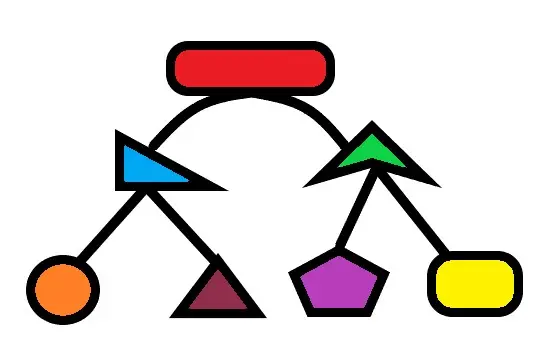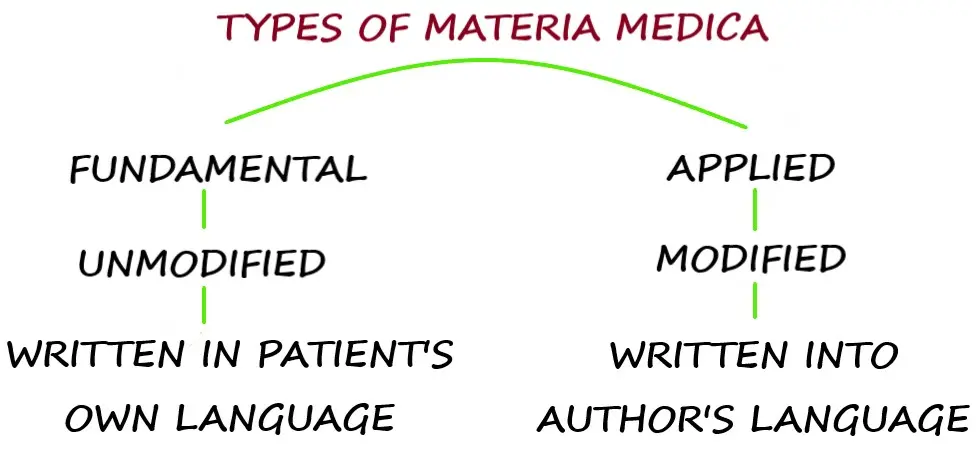
Hello there, in this post I am going to discuss about the classification and types of Homoeopathic materia medica which are written by many homeopaths all over the world.
After the experiments on Peruvian bark Dr. Hahnemann continued his proving works on other medicinal substances, which he documented one after another.
This work of his produced vast volumes of Materia Medica Pura.
Materia medica is a book that contain systematic records of the medicinal substances.
Homoeopathic Materia medica is the collection of systematically recorded homoeopathic remedies which are proved on healthy human beings of both sexes and different ages.
In short Materia medica is full of information about the medicines in detail.
Every medicine should be studied in a systematic way including clinical experiments and pharmacology (uses, effects, mode of action of drug substances).
Since the discovery of homoeopathy, the number of homoeopathic remedies has been increasing.
A lot of clinical symptoms have been added by many homoeopathic individuals throughout the world.
Approximately more than 400 books of Materia medica in English and other languages have been written.
Each Materia medica has its own advantages and drawbacks.
It is quite difficult to classify them but they can be arranged into different categories according to their content.
Chiefly Materia medica can be classified into following two types:

A. Fundamental or Unmodified Type of Materia Medica
Medicines are recorded in patient’s own language with no modification by author.
E.g. Materia Medica Pura.
B. Applied or Modified Type of Materia Medica
After obtaining the symptoms from the prover, medicines are written into author’s language with modification.
Various Materia medica can be classified under this category.
- Materia Medica of Drug Proving
- Clinical Type of Materia Medica
- Therapeutic Type of Materia Medica
- Comparative Type of Materia Medica
- Group Study Type of Materia Medica
- Pharmacodynamic type of Materia medica
- Physiological Type of Materia Medica
- Schematic (Anatomical) Type of Materia Medica
- Picture Type of Materia Medica
- Picture Method of Materia Medica
- Poetry type of Materia Medica
- Psychoanalysis type of Materia medica
- Keynotes Type of Materia Medica
- Combined type of Materia Medica
1. Materia Medica of Drug Proving
This types of Materia medica contains medicines with their proving records on healthy human beings.
- A Cyclopaedia of drug Pathogenesy – Dr Richard Hughes.
- Condensed Materia Medica – Dr Constantine Hering.
- Materia Medica Pura – Dr. Samuel Hahnemann.
2. Clinical Type of Materia Medica
In this type of Materia medica clinical symptoms of medicines have been recorded in systematic way after proving.
Advantage– Medicine selection can be easy and quick while practicing in clinics.
Drawback– Complete drug picture cannot be studied.
- A Clinical Materia Medica – Dr. E. A. Farrington.
- A Dictionary of Practical Materia Medica – Dr J. H. Clarke.
- Handbook of Materia Medica – Dr. T. F. Allen.
- Pocket Manual of Homoeopathic Materia Medica – Dr W. Boericke.
3. Therapeutic Type of Materia Medica
Group of medicines are explained under the titles of different diseases.
Example- Under diarrhoea heading different drugs effective in diarrhoea of different characteristics are explained.
Advantages-Medicine can be selected quickly.
-Number of remedies to select from reduces.
Drawback-Whole drug picture cannot be studied.
- Homoeopathic Therapeutics – Dr Lilienthal.
- Leaders in Typhoid Fever – Dr E. B. Nash.
- Practical Homoeopathic Therapeutics – Dr Dewey.
- The Prescriber – Dr J. H. Clarke.
4. Comparative Type of Materia Medica
Medicines having similar pathogenesis are compared with their differentiating points.
Medicines are also compared at different levels like symptomatic level, organ level etc.
Advantages-Useful especially when patients come with apparently similar symptoms.
-Helps to select most similimum.
Drawbacks-Whole drug picture cannot be understood.
-Not all the symptoms can be studied in this way.
- Comparative Materia Medica – Dr E. A. Farrington.
- Comparative Materia Medica – Dr N.C. Ghosh.
- Leaders in Homoeopathic Therapeutics – Dr E. B. Nash.
- Plain Talks on Materia Medica with Comparison – Dr Pierce.
- Study of Remedies by Comparison – Dr H. A. Robert.
5. Group Study Type of Materia Medica
Medicines belonging to the same family (vegetable kingdom), same group (minerals), or same species (animals or insects) express many symptoms similar to the other medicines from their own source groups.
In this type of Materia medica general features of each group are described along with their differentiating characteristics.
Medicines can be remembered easily in this way of study.
Selection of medicine also becomes more precise because we can decide that which group of medicines are applicable to the individual case.
- Lectures on Clinical Materia Medica – Dr E. A. Farrington.
- Elements and Plant Kingdom in Homoeopathy – Jan Scholten.
- Elements in Homoeopathy – Jan Scholten.
- Homoeopathy and Homoeopathic prescribing – Dr Harvey Farrington.
- Mineral in Homoeopathy – Jan Scholten.
- Textbook of Homoeopathic Materia Medica – Dr Otto Lesser.
- The Sensation in Homoeopathy –Dr. Rajan Sankaran.
- The Soul of Remedies –Dr. Rajan Sankaran.
- The Substance in Homoeopathy –Dr. Rajan Sankaran.
- The Synergy in Homoeopathy –Dr. Rajan Sankaran.
6. Pharmacodynamic Type of Materia Medica
Main importance is given to the sphere of action of each drug.
Sometimes one or more organs and systems are more influenced by few of the remedies including polychrests.
Example-Ipecac in nausea and vomiting.
-Nux vomica in gastrointestinal tract.
- The new comprehensive system of Materia medica and therapeutics- Dr. Hempel.
- Lecture on Materia medica– Carol Dunham.
- A Manual of pharmacodynamics– Dr Richard Hughes.
7. Physiological Type of Materia Medica
Medicines are written on the basis of their physiological actions.
- A Manual of Pharmacodynamics – Dr Richard Hughes.
- Botanical Materia Medica and Pharmacology– Dr S. H. Aurand.
- Characteristic Materia Medica – Dr Das Gupta.
- Materia Medica and Pharmacology– Dr Culbreth.
- Materia Medica and Therapeutic – Dr C. J. Hempel.
- Materia Medica and Therapeutics – Dr Shoemaker.
- Materia Medica of Therapeutics and Pharmacology – Dr Blackwood.
- Physiological Materia Medica – Dr W. H. Burt.
- Text book of Materia Medica and Therapeutics – Dr Cowperthweite.
- Therapeutics, Materia Medica and Toxicology – Dr H. C. Wood.
Note: A doctor must know the physiological and pathological actions of a drug he prescribes especially when summoned to the court in order to explain the reasons for selection of that particular medicine.
8. Schematic (Anatomical) Type of Materia Medica
Medicines are written in systemic way against each organ.
It makes easy to search the symptoms of particular parts of the body.
Drawbacks– Peculiarity of symptoms cannot be discovered easily due to fragmental studies.
Example- Suppose a patient is having dry lips and dry tongue with complete absence of thirst, if both the symptoms are written under different sections like Mouth, Face or Thirst. So, real peculiarity of the symptom cannot be traced easily.
- Encyclopaedia of Pure Materia Medica – Dr T. F. Allen.
- Hand book of Materia Medica and Homoeopathic Therapeutics – Dr T. F. Allen.
- Manual of Materia Medica – Dr W. Boericke.
- Materia Media and Special Therapeutics – Edwin Hale.
- Materia Medica Pura – Dr Hahnemann.
- Textbook of Materia Medica – Dr Cowperthwaite.
- Textbook of Materia Medica – Dr Lippe.
- The Dictionary of Practical Materia Medica- Dr J. H. Clarke.
- The Guiding Symptoms of the Materia Medica – Dr C. Hering.
9. Picture Type of Materia Medica
Dr. J T Kent introduced this method in which individual personality of remedy can be picturized.
Drug pathogenesis are described in very simple and elaborated manner so, individual drug picture can be studied.
Medicines also can be compared very easily.
Best suitable for the homoeopaths who are studying.
Drawback-Quick reference may not be that easy.
- A Textbook of Materia Medica – Dr N. M. Choudhary.
- Children’s Type of Materia Medica – Dr Borland.
- Homoeopathic Drug Pictures – Dr M. L. Tyler.
- Homoeopathic Materia Medica of Graphical Drug Picture – Dr Pulford.
- Leaders in Therapeutics – Dr E.B. Nash.
- Lectures on Materia Medica – Dr J. T. Kent.
10. Picture Method of Materia Medica
Medicine are described in pictorial (graphical representation) style.
By studying the pictures, students can grasp the central idea of medicine very easily.
We can remember the outlook of personality with important keynote symptoms.
- Materia Medica for Students – Dr. Ritu Kinra.
- Expressive Drug Pictures of Homoeopathic Materia Medica- Dr. R.K. Chauhan.
- Picture it: Homeopathy- Aarti Patel.
- Enjoy learning homoeopathy- Dr. John English.
11. Poetry type of Materia medica
Medicines are described in a poem fashion in the form of stanza.
Makes it easy to remember the medicines in entertaining and informative way.
- Materia Poetica – Dr. Sylvia Seroussi Chatroux.
It contains about 101 original poems on homoeopathic remedies.
- Enjoy learning homoeopathy- Dr. John English.
12. Psychoanalysis type of Materia medica
Medicines are individualized on the basis of their personality, temperament etc.
Mental symptoms and psychological characteristics are described which are useful in cases with more mental symptoms.
Drawbacks– Physical and clinical symptoms are not included.
- Homoeopathic psychology– Philip M. Bailey.
- Portrait of Homoeopathic Materia Medica- Catherine Coulter.
- Essence of Homoeopathic Materia Medica– George Vithoulkas.
13. Keynotes Type of Materia Medica
Predominating symptoms of medicines are written.
Helps to find similimum when we have a group of totality of symptoms.
Special importance is given to peculiar, rare, uncommon, striking, characteristic and individualizing symptoms.
Advantage-Quick selection of remedy is possible while practicing in clinics.
Drawbacks-Not suitable for learning students.
-Whole drug picture cannot be studied.
-It is a shortcut and time saving but is often misused.
- A Primer of Materia Medica – Dr T. F. Allen.
- Booklet on Materia Medica – Dr Noel.
- Characteristic Materia Medica – Dr Hawke.
- Characteristics Cards – Dr Hering.
- Keynotes and Characteristics – Dr H. C. Allen.
- Keynotes and Redline Symptoms – Dr A. V. Lippe.
- Keynotes of Leading Remedies – Dr H. C. Allen.
- Quiz Compendium – Dr Dewey.
- Symptomatic Key to Materia Medica – Dr C. M. Boger.
14. Combined Type of Materia Medica
Many homoeopathic stalwarts have tried to represent all the types mentioned above.
The core of the remedies is described in brief including their important characteristics.
Readymade, easy to remember and provides an outline of the whole remedy.
- Descriptive Materia Medica – Dr Catherine coulter.
- Essentials of Materia Medica – Dr George Vithoulkas.
- Lotus Materia Medica – Dr Robin Murphy.
- Materia Medica of Nosodes – Dr H. C. Allen.
- Materia Medica Viva – Dr George Vithoulkas.
- Soul of Remedies – Dr Rajan Sankaran.
- Symposium Volumes – Dr M. L. Dhawale.
- Systemic Materia medica- K.N. Mathur.
- Tautopathic Materia Medica – Dr O. A. Julian.
- Textbook of Inorganic Materia Medica – Dr Otto Lesser.
- Textbook of Materia medica – S.K. Dubey.
- Textbook of Materia medica- M Mohanty.
Conclusion
So, we observed that each homoeopath has developed his/her own systematic way to write the Materia medica.
Each Materia medica has its own scope and limitations that you can learn in a separate post.
Most suitable method observed in many homoeopaths is to understand the groups with characteristic mental and physical general symptoms and the individualizing characteristics of each remedy.













congratulations and success for such a great job thanks for your contribution